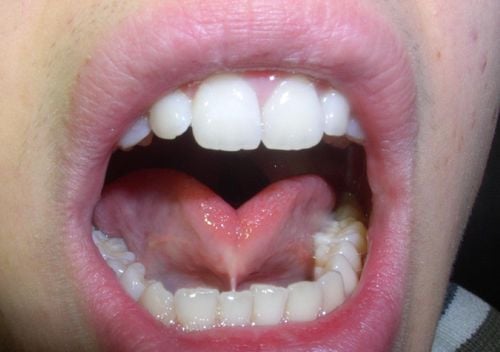This is an automatically translated article.
Difficulty opening the mouth and swallowing after cancer treatment is common in tumors in the mouth or throat, or due to tumor treatment such as surgery or radiation therapy for these areas. Effects can vary from mild to severe problems with sensation and movement of the mouth. Read on to learn about some of the speech and swallowing aids for head and neck cancer survivors.
1. Difficulty swallowing, difficult to open mouth after cancer treatment.
Surgery or treatment for head and neck cancer can cause changes to the patient's mouth such as the lips, teeth, tongue, floor of the mouth, cheeks, palate, or throat, pharynx, or larynx, which can affect the patient's ability to speak or swallow. These changes can be temporary or permanent and can affect the patient's daily life. A speech pathologist can help you with any difficulties you are having with swallowing and communication.
The patient will experience some cases such as:
Food or liquid comes out of the mouth. Food stuck in the mouth. Difficulty chewing or moving food to the back of the mouth. Food gets stuck in the throat or enters the nasal cavity. Food enters the airways. Many of these problems are the result of muscle loss (atrophy) in the head and neck area due to disuse or damage from treatment. Tissue damage from radiation can develop years after treatment.
2. Speech and swallowing support for head and neck cancer survivors
2.1. Improved communication Treatment for patients with head and neck cancer can cause certain language difficulties, such as: slurred speech, raised nasal sounds, or speaking too softly.
In case the right larynx is removed, the patient will lose the ability to speak. If communication difficulties are left untreated, the patient may become depressed or socially isolated. Therefore, patients need to be helped by a speech therapist as soon as possible.
When the patient is unable to use oral language to communicate, the doctor will advise an alternative method, such as the use of external communication aids. For patients who have had their vocal cords removed, speech therapists will talk in a special way to encourage them and help them find the best way to communicate. These methods may include:
Speak from the esophagus: Speak by pushing air to the food pipe. Artificial larynx: Using external devices such as electronic larynx to produce sound. Esophageal Pseudotracheal (TEP): Speaks through a small one-way valve to move air from the trachea to the pharynx. Specialists can help patients maintain communication by writing on paper or a whiteboard. Or through speaking strategies including:
Say one word or phrase at a time Slow down your speech Check if the person talking to the patient understands what the person is saying Avoid speaking when the person is tired Use Use drawing, pointing, or gesture gestures to help convey the patient's message Over-pronouncing or exaggerating the sound of the patient's voice. 2.2. Improve swallowing function Dysphagia in patients with head and neck cancer after treatment includes difficulty eating. Chemotherapy and radiation therapy can weaken the swallowing muscles and leave scarring that limits movement.
This condition can cause the person to take longer to eat, difficulty chewing dry foods, food stuck in the throat after swallowing, food or liquid spilling from the nose, coughing and choking during or after swallowing. If dysphagia is not treated, the patient is prone to malnutrition and dehydration. Severe cases can cause pneumonia and chronic lung disease.
In addition to the above obstacles, the patient loses interest in eating and social isolation. Therefore, speech therapists need to be present early to assess the patient's swallowing ability, and work with them to face and overcome these difficulties.
To assess the ability of the pharynx to swallow, the doctor prescribes endoscopy (VFS or FEES). After the assessment, the speech therapist will recommend appropriate changes in swallowing. These changes may include a change in posture, a change in diet, or a trick to swallow. If the patient is unable to swallow safely despite the rehabilitative methods, the medical staff will use an alternative feeding method. Speech therapists also help patients with physical therapy to rehabilitate the swallowing muscles.
Regarding the timing of speech and swallowing therapy, physicians should advise patients to consider starting therapy before cancer treatment and continuing until treatment is complete. Studies show that speech and swallowing therapy started before cancer treatment helps maintain better muscle function, thereby improving a patient's quality of life after cancer treatment.
Signs of dysphagia may include:
Coughing or choking when eating or drinking Feeling the need to clear your throat after eating or drinking The patient may get wet after eating or drinking The patient becomes short of breath during , after eating or drinking Food or drink gets stuck in the throat of the sick person. Feeling like the patient needs to swallow several times to clear food or drink from the throat Discomfort when swallowing The patient takes longer to finish a meal than usual Food or drink comes out of his or her nose patient. Difficulty chewing food If a patient is experiencing any of these difficulties, it is important to see a speech-language pathologist. The speech-language pathologist can give you recommendations on the safest and most comfortable food and drink, initiate swallowing therapy and, if necessary, conduct further testing of the patient's ability to swallow. .
Fluorescent Lens Swallowing Study (VFSS) - X-ray of the patient's swallowing process. Fiberoptic endoscopic evaluation of swallowing (FEI) - a small endoscope is inserted through the nose and into the patient's throat so that the patient's swallowing can be assessed and monitored on camera Several strategies for disease management The patient can swallow safely as follows:
Sit upright in a recliner during and after meals Maintain good oral care Avoid talking and eating at the same time Check that the inside of the patient's mouth is clean After eating do not Drink small sips of water, drink slowly. Avoid eating and drinking when tired and sluggish
3. Methods of supporting speech and swallowing after surgery for head and neck cancer.
You may need to practice exercises and techniques to correct the specific voice change you are experiencing. Techniques may include slowing down the voice, speaking louder, reducing background noise, and using context and gestures. There are apps for the patient's smartphone to help the patient with these exercises. In some cases, it may be helpful for patients to use tools to help them communicate better. Tools include text-to-speech applications, electronic speech generators, electromechanical devices, and prostheses. When should I see a specialist?
Patients can see specialists for evaluation immediately after diagnosis or treatment of the head and neck. You can also see a specialist at any time after treatment if there are changes in function or to see if any new treatments are available. If there is a change in your swallowing function at any time after treatment, you may need to see a doctor right away. Some notes of patients after surgical treatment. The patient should have changed the consistency of the food that the patient can eat. It takes several swallows to get all the food out of the mouth and throat. After swallowing, the person may have a harder voice. The patient clears his throat while eating. Pay attention to the patient's weight. The patient is dependent on a tube for feeding. The patient has a history of pneumonia. There are many ways that can help people deal with problems they may have related to a diagnosis of head or neck cancer. If the person is having problems speaking or swallowing.
Please dial HOTLINE for more information or register for an appointment HERE. Download MyVinmec app to make appointments faster and to manage your bookings easily.
References: headandneckcancer.org.au, hartfordhealthcare.org













